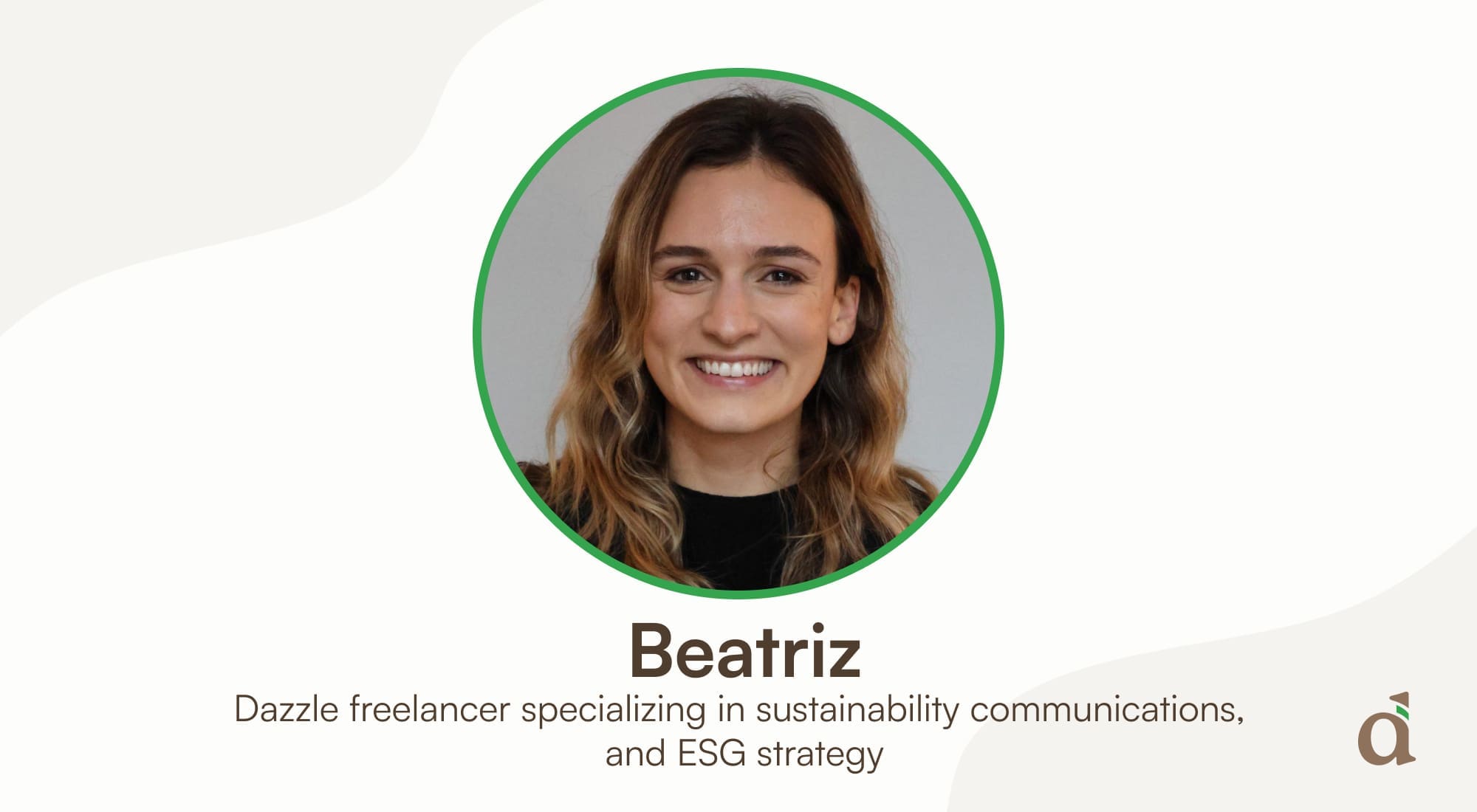There once was a time when sustainability reporting really wasn’t a big deal.
It was an entirely voluntary practice, only taken seriously by a handful of forward-thinking companies.
Fortunately though — we are well aware that many out there would say unfortunately! — comprehensive and transparent sustainability reporting is expected of companies today. And in many places, it has become mandatory. (Did somebody say CSRD?)
If companies today want to comply with regulations and keep their stakeholders happy, effective sustainability reporting is a must.
That’s why we’ve created this article. To help you write an effective sustainability report, and just as importantly, communicate your report in all the right ways.
We will also touch on the benefits of sustainability reporting (hence why we said fortunately above!). But to make absolutely sure we’re all starting on the same page, let’s first clarify exactly what we mean by sustainability reporting.
What is sustainability reporting?
In a nutshell, sustainability reporting is the process organizations use to disclose non-financial performance information to stakeholders. Particularly, information about their performance and impacts on a range of sustainability topics, usually spanning environmental, social and governance (ESG) parameters. (Carbon emissions, energy use, social initiatives, and governance practices are some commonly covered topics).
Through sustainability reporting, organizations can demonstrate transparency and accountability, and highlight progress towards sustainability goals.
Typically, organizations will create one sustainability report each year, which documents their relevant progress over the previous 12 months.
Sound like a whole lot of unnecessary work? Honestly, that couldn’t be further from the truth. Once you start taking sustainability reporting seriously, you start to notice how beneficial it can be.

What are the benefits of sustainability reporting?
That’s because sustainability reporting is about more than just accountability. For the most successful companies, reporting also represents an opportunity to improve in key areas. To create value, enhance reputation, and contribute to a more sustainable future. Taking such a positive approach to sustainability reporting can lead to several important benefits:
- Better Stakeholder Relationships: Effective sustainability reporting requires complete transparency, and the disclosure of accurate information. By being transparent in this way, organizations build trust with key stakeholders. Reporting also demonstrates an ongoing commitment to addressing important environmental and social concerns. From our experience, this tends to have a very positive effect on stakeholder engagement and loyalty.
- Enhanced Risk Management: Through the process of sustainability reporting, organizations inevitably gain a better understanding of potential ESG-related risks. These insights can then be used to develop strategies to mitigate these risks.
- Competitive Advantages: Consumers are becoming more environmentally conscious. The workforce more values-driven. Investors are increasingly becoming interested in sustainability. Creating a comprehensive, engaging sustainability report offers an effective way to appeal to these forward-thinking stakeholders. And of course, to stand out from your competitors.
- Continuous Improvement: You can’t put together an accurate sustainability report without tracking key sustainability metrics and monitoring progress. And this process usually encourages organizations to set and achieve goals, and strive for constant and long-term improvements.
- Regulatory Compliance: With legislation like the Corporate Sustainability Reporting Directive (CSRD) coming into force recently, sustainability reporting is rapidly becoming a legal requirement across the world. So wherever organizations are based, learning how to do sustainability reporting well can help them avoid trouble with the law!
- A Better World: All of the benefits we’ve discussed so far are related to the organization doing the reporting. But we feel it would be quite silly not to mention possibly the most important benefit we can take from all of this. The fact that sustainability reporting motivates or at least pressures organizations to become more sustainable, and therefore more planet-friendly. That’s the whole reason sustainability reporting became a thing in the first place. To help make the world a better place for everyone.
We know that is something you are trying to do too. So please, use the following tips to tell the world about your efforts.

Tips for writing your sustainability report
Preparation and planning
You didn’t think you were just going to start writing straight away did you!?
As fun as that would be, the key to an effective sustainability report is largely found in the preparation. Here’s what you need to consider before putting pen to paper. (‘Fingers to keys’ just doesn’t have the same ring to it, does it?):
- Identify Your Sustainability Reporting Framework: Depending on where your organization is based, the framework within which you write your sustainability report will differ. If you’re based in the EU for example, you will need to write your report according to CSRD guidelines. Whereas in other regions, the Global Reporting Initiative (GRI) standards may be more relevant. So before you do anything else, we would recommend finding out which framework it is you need to follow.
- Assemble a Team: A whole lot of work goes into creating an effective sustainability report, so you will need to put together a team that’s up to the job. And this isn’t just about grabbing a few people from an existing sustainability team. You’re going to need data analysts and communications experts, and each department will have to contribute any information that’s relevant.
- Gather the Data: With the dream team in place, it’s time to pull together the essence of your report; the data. The particular reporting framework you are using (CSRD or GRI etc) will determine exactly what data is relevant here. But generally, you will need to collect reliable and consistent metrics on several ESG-related topics.
Writing the report
Data is great and all, but it doesn’t really tell an engaging story does it?
And that is what you are trying to do here; take all your relevant sustainability data, and turn it into a story that makes your stakeholders sit up and listen.
Here are some tips to help you do just that:
- Be Transparent and Honest: With sustainability reporting, authenticity is the name of the game. That means being honest about the challenges you’re facing, and the areas you need to improve. When you openly discuss these ‘negatives’ as well as your achievements, you build credibility with your audience. (If all the reader can see is you boasting about success after success, they’re going to assume you’re not telling them the full story, and they will lose interest).
- Avoid Greenwashing and Exaggeration: This really goes hand in hand with the transparency and honesty, but still, it’s important enough to explicitly emphasize here; never ever engage in greenwashing or make exaggerated claims. This isn’t going to convince anyone for long, and it won’t help you comply with regulations like the CSRD or the Green Claims Directive.
- Keep it Simple and Structured: You want to keep your reader engaged here, so don’t use too much overly technical language or jargon. Use clear, concise language to make your report accessible to a wide audience. And within the constraints of whatever framework you’re using, make sure to organize your content logically, in an order that makes sense. While also using headings, subheadings, and bullet points for easy navigation.
- Tell a Story: Your sustainability report should be packed full of quantifiable metrics and relevant data to back up any claims you make. But to keep your readers interested, you should try to use all this data to tell a relatable, human story. Sustainability storytelling is all about weaving your facts together in a way that portrays the real-world impact of your sustainability efforts. Instead of just sharing about the number of trees you’ve planted for example, you might focus on the story around the trees. Maybe talking about how these tree-planting initiatives have transformed local communities for the better, by providing jobs and regenerating land.
- Utilize Graphics: Wherever it is necessary to present complex data, infographics and charts offer an effective way to present it succinctly, and clearly. And beyond this, you should take advantage of visuals wherever you can. Make sure the report looks professional, and eye-catching. (Ideally, your report should be designed by a professional graphic designer, as a well-designed report can do wonders for keeping readers interested).
- Highlight Stakeholder Engagement: A great way to further demonstrate your commitment to transparency and continuous improvement is to show how you’ve involved stakeholders in the reporting process. For example maybe some of the relevant data you collected came from customer focus groups or employee surveys. If this is the case, these are definitely things you should highlight and include where appropriate in your report.
- Talk About Future Goals: So far, you’ve taken all of your complex data and metrics, and weaved it into an engaging, relatable, graphically-gorgeous story that has kept your audience glued to the screen. But it’s also important to talk about your future goals, so that readers will know your efforts are ongoing, and not just a one-off project.
- Review and Revise: Before you decide your report is ready for sharing, always always make sure it is first well-edited for accuracy, coherence, and consistency. It can also be worth seeking feedback from stakeholders before finalizing it, to ensure clarity and relevance.
And suddenly, once all the revisions are done, and you’re happy that your report tells your honest story in the most engaging way possible, it is time to share it with the world!
If you want to do this well, believe us, it involves a lot more than simply pressing the post button.

How to communicate your sustainability report effectively
For your sustainability report to make a meaningful impact, you’ll need to get it in front of the right audiences. In a way that makes them pay attention. To do that, consider the following tips:
- Think About Your Audiences: Before putting a communication strategy together, it’s important to remember the different stakeholders who need to see your report. Customers, employees, investors, regulators etc. Each of these stakeholder groups will be interested in different parts of the report, and will respond better to different language and tone. So regarding the parts of the report you highlight, and the language you use to do so, make sure your communication is tailored to the specific interests and needs of each group.
- Distribute Through Multiple Channels: You will also have a better chance of reaching each stakeholder group through different means. Maybe email newsletters is the best way to reach your investors for example, whereas social media could be more effective for your customers, and your company website for employees. The optimal mix will be different for each company, but it will always involve distributing through multiple communication channels. So we would recommend that you determine the best way to reach each stakeholder group, and use all the channels you need. (Offering different formats, such as PDF, or an interactive web version for example, is also a good way to suit different preferences).
- Integrate into Your Broader Communications: You’ve put all this effort into writing a top-quality sustainability report, and no doubt it contains lots of valuable information and insights. So you should absolutely be integrating key points from the report into your broader corporate communications. Press releases, blog posts, annual reports, employee updates etc. Make the most of the information you have, to ensure that sustainability remains a visible and central part of your company story.
- Share Snippets on Social Media: Of course, social media is one of the best tools you can use to get your report out far and wide into the world. So definitely take advantage of it by sharing key statistics, achievements, quotes, goals, or infographics that encapsulate the report’s highlights. Maybe even put together some short attention-grabbing videos that quickly run through the report’s best bits. This can really help to increase initial engagement, and drive traffic to the full report.
- Host Webinars or Virtual Meetings: Social media is all about snippets, but some of your stakeholders will be more interested in deeper discussions about particular aspects of your report. So why not consider hosting webinars or online events to discuss the report’s content? Here you can present the key findings, and answer any questions different stakeholders might have. This offers a great opportunity to engage directly with stakeholders and provide further context. And you can also create a buzz around these events, which helps to draw even more attention to the report itself.
- Engage with Stakeholders Directly: And that’s not the only way to engage with stakeholders directly. We would also recommend sharing your report directly with key stakeholders, where appropriate, through personalized emails or meetings. When doing this, you can also seek direct feedback, and encourage a dialogue about how your sustainability efforts can continue to improve.
And that’s one of the main reasons we’re doing all this reporting really isn’t it? To track today’s performance, so that we can improve tomorrow. Conveniently, this thought brings us very nicely on to our next point!
Always measure and improve
From here on out, it’s likely that you’ll be creating one of these sustainability reports every year. And every year, your report should ideally get better.
To ensure that it does, it’s important to always measure your report’s impact. That means tracking report page visits, downloads, and engagement metrics. Monitoring likes, shares, and comments on social media. Tracking open rates, click-through rates, and downloads from any emails you sent with the report attached. And also gathering direct insights from stakeholders via surveys, focus groups, forums, or informal conversations, to assess how well the report resonates.
By obtaining these kinds of metrics and feedback, you can assess the success of your report. So that next year, you can improve your sustainability reporting process, your report’s content, and your communication strategy.
Or if you fancy getting all of that on-point this year, we’d be happy to hook you up with a top sustainability reporting expert today!

Make sure your sustainability report is a success with Dazzle
Not sure if we mentioned this yet, but Dazzle is the platform where the world’s best sustainability freelancers hang out.
Well, not just hang out. We’ve got top-quality sustainability reporting and sustainability communications experts here, ready to help you smash it with your report this year!
A proven track record comes guaranteed with Dazzle, as all of our freelancers are extensively pre-screened. While the process is also very flexible, because you can choose to work with our freelancers on a project-based, on-demand, or interim basis.
So if you want to maximize the success of your next sustainability report, while making the whole process much easier for you, why not contact us today?
Within hours, we can send you several expert freelancer profiles, so that you can easily find the perfect fit.
From there, you can be confident that your next sustainability report will look the part, and be seen by all the right people.
(Feel free to check out our ultimate sustainability communications guide to find out everything you need to know!)





